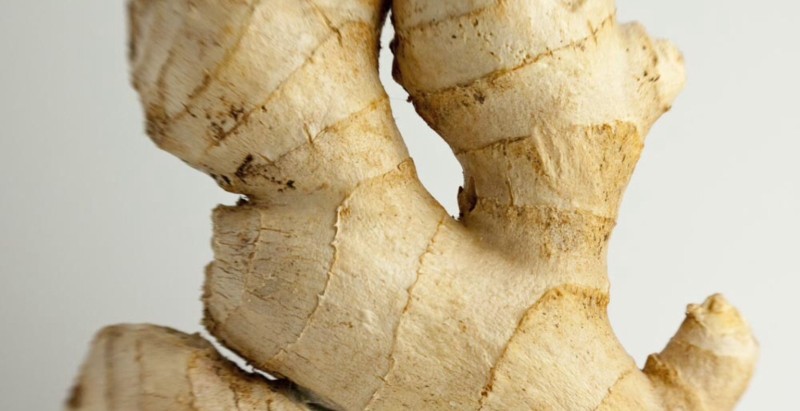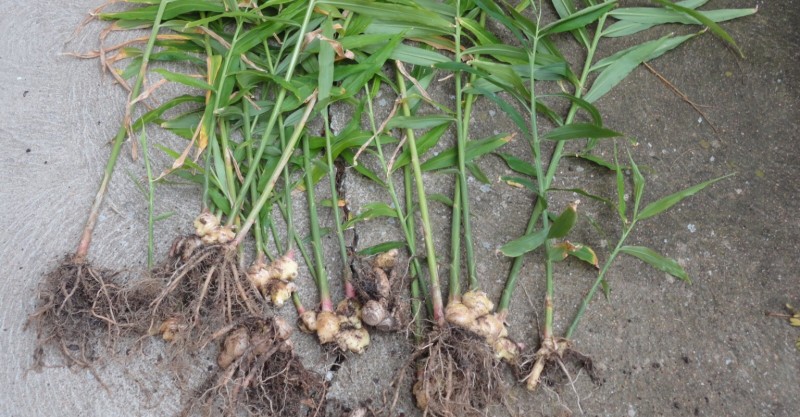Ginger root is a commonly used culinary ingredient and/or herbal medicine that’s currently in use nearly anywhere that you can go in the world — in a number of different forms, and/or including: ginger root tea, fresh ginger, and dried ginger.
All of which are thought to have somewhat different medicinal effects — largely owing to the difference in relative-proportions with regards to the active-compounds, which are thought to be: the gingerols, zingerone, and the shogaols.
The root (rhizome actually) of the ginger plant (Zingiber officinale) has been in use by humans for several thousand years now. (At the very least ~5000 years, possibly much longer — it bears remembering that taro root has been cultivated in that part of the world for at least 28,000 years now, after all.) It’s currently thought that the plant was originally native to southern China — but given the high degree of deforestation that that region has seen over the last few thousand years, it’d be hard to say for sure.
As with most of the other members of the family Zingiberaceae, the ginger plant is a herbaceous perennial which produces roughly meter-tall stems annually. While the plant is grown throughout South Asia, West Africa, and the Caribbean, India is far and away the top producer currently.
There are a number of close relatives of the species that are cultivated for human use as well, including: turmeric, galangal, and cardamom, for example.
Ginger Root Health Benefits
Ginger root has been considered by many folk medicine traditions to be an effective remedy for nausea, inflammation, the common cold, vomiting, constipation, fatigue, coughs, and headaches.
Modern scientific research has backed a fair amount of this up, despite research on the subject being relatively sparse to date.
Here’s some of the key findings:
- Research has found ginger to be more effective than placebo for treating nausea — whether caused by seasickness, morning sickness, or chemotherapy.
- Research concerning possible mutagenic effects (especially during pregnancy) have been contradictory — some studies have shown possible mutagenic activity, some have reported antimutagenic effects. So hard to say on that count.
- In laboratory settings (using test animals…) gingerols have been shown to increase the motility of the gastrointestinal tract — and to possess analgesic, sedative, antipyretic, and antibacterial properties.
- A study from researchers at the University of Michigan found that gingerols can inhibit growth of ovarian cancer cells in vitro.
- Ginger triggers the production of saliva — thereby making swallowing easier for those with throat injuries/illnesses.
- Some studies have found that ginger may provide some relief with regard to pregnancy-related nausea and vomiting.
- Research has found ginger to be somewhat effective in reducing the pain associated with painful periods.
- There’s strong evidence that ginger can reduce the pain associated with osteoarthritis.
- It may also help with headaches, swelling, high blood sugar, high cholesterol, and/or muscle pain.
- Reportedly, “ginger water” is also useful as a means of reducing the likelihood of heat cramps while working out doors.
As stated before though, not much scientific research has actually been done on the subject (for whatever reasons…).
On that note we’ll now go over some of the traditional medicinal uses of ginger from various cultures around the world:
- In India ginger is often applied as a paste to the temples to relieve headaches. The fresh root is also consumed to reduced nausea, and to treat the symptoms of colds/flus.
- In the country of Burma, ginger is taken together (after boiling) with palm tree juice (htan nyat) to prevent the flu/colds.
- In China ginger root was traditionally used to treat a variety of ailments, including the flu, inflammation, arthritis, and coughing illnesses. Apparently a common home remedy in some parts of the country is/was to mix fresh ginger with scrambled eggs — “ginger root eggs”.
- Ginger is mixed with mango tree sap to make tangawisi juice in Congo, which is used as a panacea.
- Ginger is used in Colombia to treat cold and flu-like symptoms.
- In Indonesia ginger is used to combat fatigue + prevent and cure rheumatism.
- In Nepal, ginger is used medicinally to treat colds.
Ginger Side Effects
In the quantities that typically are consumed by people, ginger root possesses few side effects, and is classified by the FDA as being “generally recognized as safe”.
There are a few known side effects with regard to prescription drug interactions though. In particular, the effectiveness of the anticoagulant drug warfarin is limited by some of the compounds in ginger root.
Given the relatively strong effect of the various compounds in ginger on some aspects of human physiology, it seems likely that these may interact to some degree with other common prescription medications — but the evidence on that account is sparse.
Ginger Tea Uses
Ginger root tea is used all around the world as an effective means of reducing nausea (even from motion and sea sickness), and of treating “the common cold”.
Making ginger root tea is really quite simple, simply slice a ginger root into very thin slices and place them in hot clean water (water right off the boil) — just like making most other types of tea.
If you want to add other ingredients you can as well, of course — whether that’s other medicinal herbs (stinging nettles for example), lemon, honey, etc.
Image Credits: Flower via Flickr CC; Public Domain; Screen Capture





